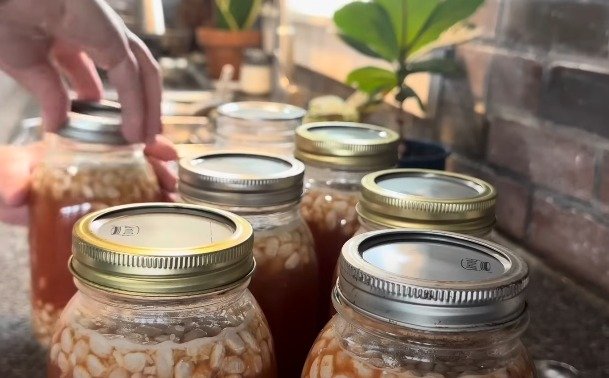Traditional Homesteading: From Canning Beans to Planting Potatoes

beans
1 tbsp dried onion
1 tsp salt
apple cider vinegar
mustard
brown sugar
ketchup
1
Title: Traditional Homesteading: From Canning Beans to Planting Potatoes
Welcome back to Homesteading with the Zimmermans, where hard work and old-fashioned skills meet modern-day living in Iowa. As former members of the Old Order Mennonite community, the Zimmermans have embraced a lifestyle that marries tradition with innovation. In this article, we'll delve into their recent homesteading activities, from canning baked beans to sprouting sweet potatoes.
Canning Baked Beans: A Homestead Staple
In the Zimmermans' homestead, canning is more than just a preservation method; it's a way of life. Ruthanne Zimmerman takes us through the process of canning baked beans, a staple in their pantry. Contrary to conventional wisdom, they skip the overnight soaking of dry beans, finding that it yields a mushier texture. Instead, they opt for dry canning, a method that retains the beans' integrity while ensuring safety.

2
The process begins with measuring out one cup of navy beans per quart jar. Ruthanne adds a tablespoon of dried onion, a teaspoon of salt, and a tablespoon of apple cider vinegar to each jar. The addition of vinegar increases acidity, making the environment hostile to botulism, a crucial safety consideration in canning.

3
A dash of mustard, brown sugar, and homemade or store-bought ketchup follows suit, adding flavor and depth to the beans. Ruthanne emphasizes the importance of wiping jar rims clean before sealing them with canning lids. After processing in a pressure canner for 90 minutes, the jars are left to cool gradually, preventing boiling over.

4
Preserving Potatoes: From Cold Room to Canning Jar
With their focus on self-sufficiency, the Zimmermans also tackle the task of preserving potatoes. Ruthanne demonstrates how they peel and dice potatoes, soaking them to remove excess starch before canning. While acknowledging that their method may not align with USDA guidelines, she stresses their confidence in the safety of their process, given the subsequent cooking of canned products.

5
Sprouting Sweet Potatoes: A Step Towards Sustainability
Looking ahead to the growing season, the Zimmermans show us their approach to sprouting sweet potatoes for planting. Using organic sweet potatoes, they employ toothpicks to suspend them in water, fostering sprout growth. This sustainable practice not only yields new plants but also reduces waste and promotes self-sufficiency.

6
Conclusion: A Blend of Tradition and Innovation
The Zimmermans' homesteading journey epitomizes the harmonious blend of traditional skills and modern techniques. From canning beans to nurturing sprouting sweet potatoes, each activity reflects their

7
commitment to self-reliance and sustainability. As they navigate the seasons on their Iowa homestead, the Zimmermans continue to inspire others with their dedication to old-fashioned living in a contemporary world.

Ingredients
beans
1 tbsp dried onion
1 tsp salt
apple cider vinegar
mustard
brown sugar
ketchup
Directions
1
Title: Traditional Homesteading: From Canning Beans to Planting Potatoes
Welcome back to Homesteading with the Zimmermans, where hard work and old-fashioned skills meet modern-day living in Iowa. As former members of the Old Order Mennonite community, the Zimmermans have embraced a lifestyle that marries tradition with innovation. In this article, we'll delve into their recent homesteading activities, from canning baked beans to sprouting sweet potatoes.
Canning Baked Beans: A Homestead Staple
In the Zimmermans' homestead, canning is more than just a preservation method; it's a way of life. Ruthanne Zimmerman takes us through the process of canning baked beans, a staple in their pantry. Contrary to conventional wisdom, they skip the overnight soaking of dry beans, finding that it yields a mushier texture. Instead, they opt for dry canning, a method that retains the beans' integrity while ensuring safety.

2
The process begins with measuring out one cup of navy beans per quart jar. Ruthanne adds a tablespoon of dried onion, a teaspoon of salt, and a tablespoon of apple cider vinegar to each jar. The addition of vinegar increases acidity, making the environment hostile to botulism, a crucial safety consideration in canning.

3
A dash of mustard, brown sugar, and homemade or store-bought ketchup follows suit, adding flavor and depth to the beans. Ruthanne emphasizes the importance of wiping jar rims clean before sealing them with canning lids. After processing in a pressure canner for 90 minutes, the jars are left to cool gradually, preventing boiling over.

4
Preserving Potatoes: From Cold Room to Canning Jar
With their focus on self-sufficiency, the Zimmermans also tackle the task of preserving potatoes. Ruthanne demonstrates how they peel and dice potatoes, soaking them to remove excess starch before canning. While acknowledging that their method may not align with USDA guidelines, she stresses their confidence in the safety of their process, given the subsequent cooking of canned products.

5
Sprouting Sweet Potatoes: A Step Towards Sustainability
Looking ahead to the growing season, the Zimmermans show us their approach to sprouting sweet potatoes for planting. Using organic sweet potatoes, they employ toothpicks to suspend them in water, fostering sprout growth. This sustainable practice not only yields new plants but also reduces waste and promotes self-sufficiency.

6
Conclusion: A Blend of Tradition and Innovation
The Zimmermans' homesteading journey epitomizes the harmonious blend of traditional skills and modern techniques. From canning beans to nurturing sprouting sweet potatoes, each activity reflects their

7
commitment to self-reliance and sustainability. As they navigate the seasons on their Iowa homestead, the Zimmermans continue to inspire others with their dedication to old-fashioned living in a contemporary world.

Leave a Review
Please log in or register for a new account in order to leave a review.










